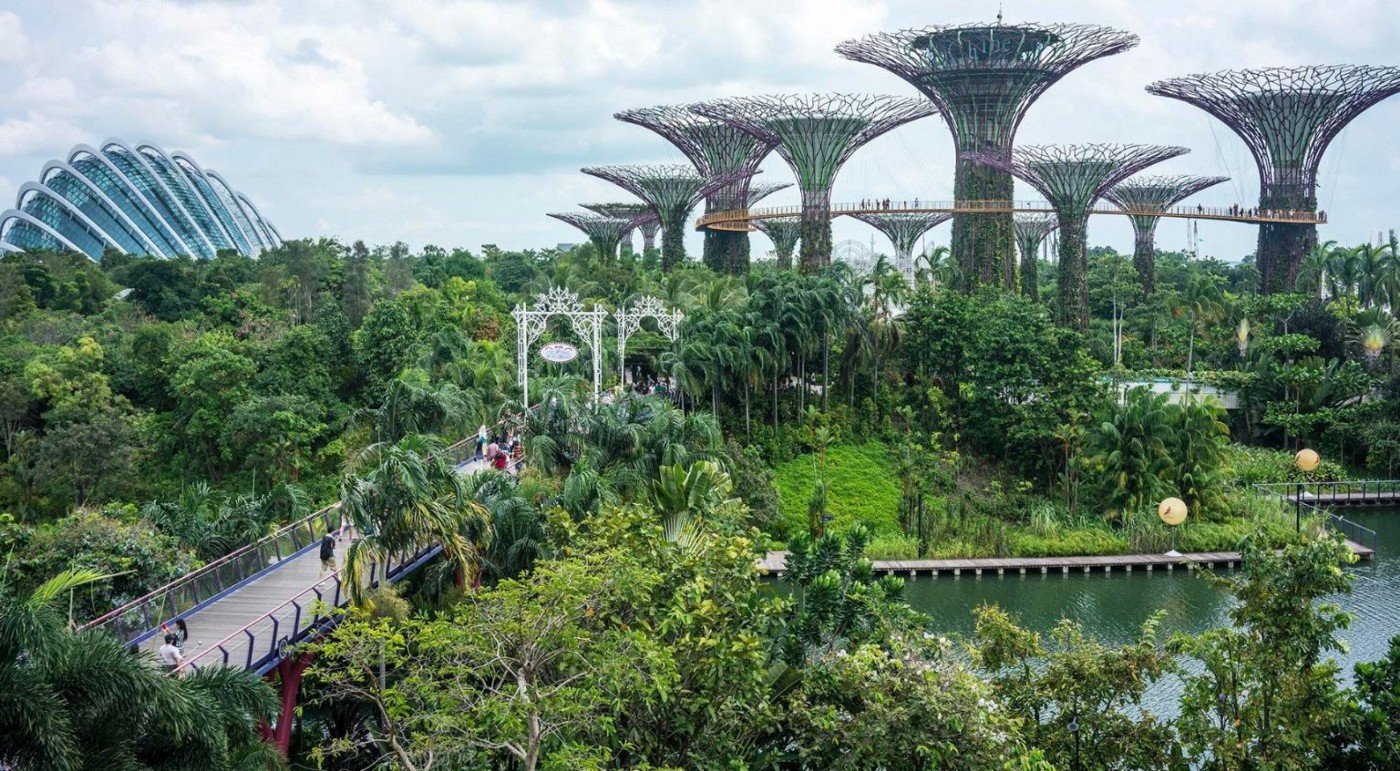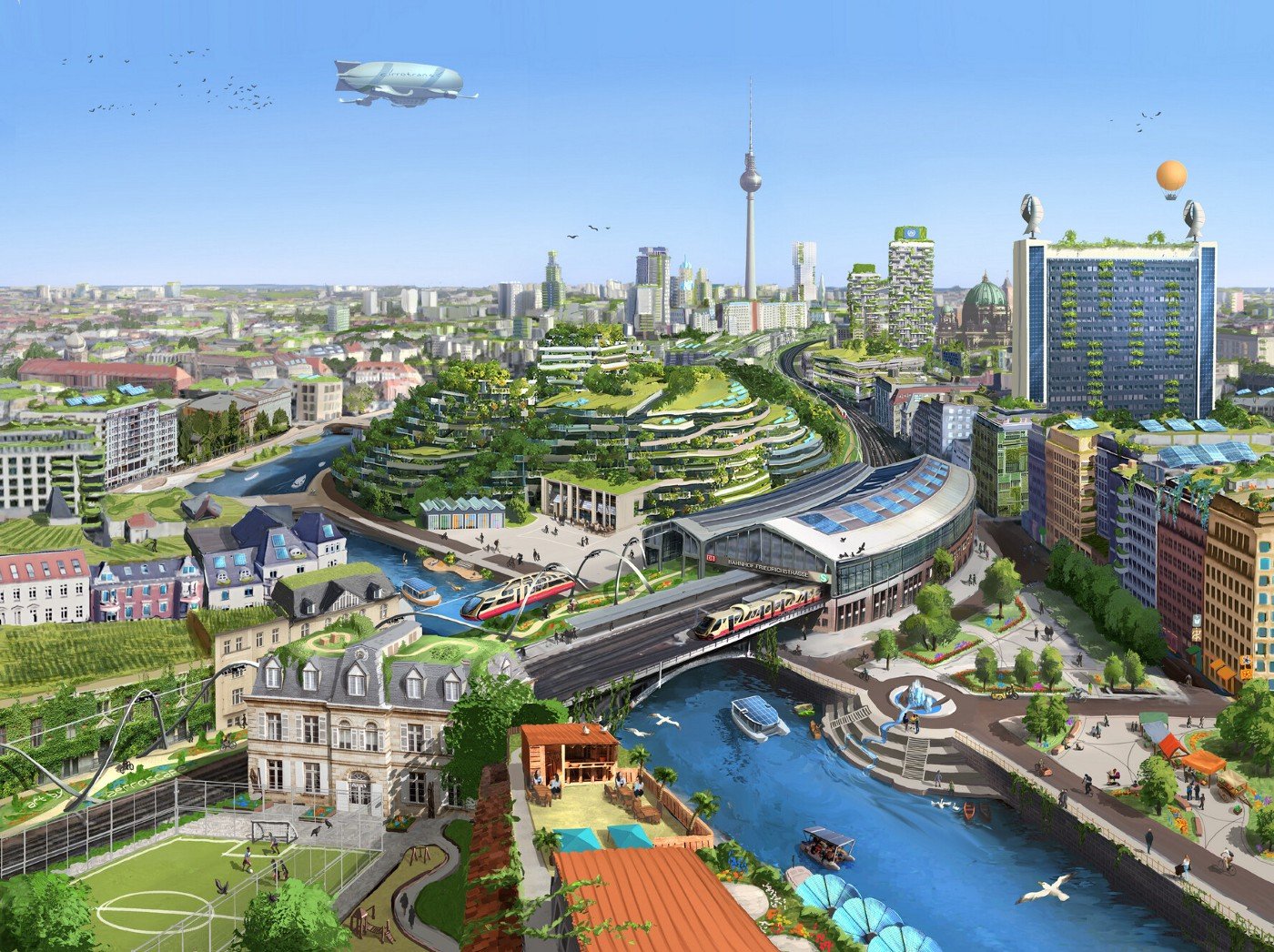How do you "solarpunk" a whole society? If we want to make radical green change attractive, we'll have to learn
From LinkedIn
We’ve been covering the phenomenon of solarpunk - as literary genre and social movement - since 2017. The earliest definition we found was this:
Solarpunk is the first creative movement consciously and positively responding to the Anthropocene. When no place on Earth is free from humanity's hedonism, Solarpunk proposes that humans can learn to live in harmony with the planet once again.
Solarpunk is a literary movement, a hashtag, a flag, and a statement of intent about the future we hope to create. It is an imagining wherein all humans live in balance with our finite environment, where local communities thrive, diversity is embraced, and the world is a beautiful green utopia.
The "solar" in Solarpunk is both a description and metaphor for the movement's commitment to a utopia that is accessible to every human on earth, as well as to all of our planet's lifeforms. No single business can capture and privatize sunlight to hoard it for itself or sell it at a cost. It's one of the only universally accessible goods. Solarpunk futures envision a world of distributed clean energy, available and benefiting everyone.
More here. The idea has been gathering momentum since then. So we were excited to find two serious essays from the public philosopher Hanzi Freinacht, who is a proponent of “metamodernism” - a school of thought that moves on from the relativism of postmodernism, recognising we face real and huge collective challenges.
But metamodernism wants to retain that sense of creativity and bold leaps of thought from po-mo - coming up with new ways to address climate catastrophe, pandemic, technological acceleration, etc.
In Freinacht’s first essay, he lays out how solarpunk might be useful:
Without an aesthetic program, it is impossible to truly recreate today’s society in desired directions. We need more than just ideas of the things we wish to avoid (ecological disaster, pandemics, famine, wars, existential risks from technology…).
We need more than a moral mission (e.g. “remedy suffering” or “save the animals” as discussed in one of my previous articles) or even the search for truth (“the mysteries of the universe, as revealed by science, in humanity’s greatest quest…”).
We also need an aesthetic longing that calls us: a sense of beauty, of good taste, of inspiration, of creativity.
The Nazis understood this very well. And so do the authoritarian regimes of today. Democratic nice guys, on the other hand, seem to struggle grasping this. As such, only authoritarian regimes have successfully managed to apply the aesthetics that speaks to the longings of 21st century humans: solarpunk.
I believe that the solarpunk movement and its aesthetics offer some of the most viable pathways for such an impulse — one that is capable of carrying forward transition (to sustainability) and transformation (of social reality).
Solarpunk can be a vehicle of metamodernist visions, not as a set of abstract ideas and ideals, but as something that is viscerally experienced through the senses and thus easy to communicate and build momentum and movement around. Solarpunks (i.e. people committed to this design sensibility) can be purveyors of metamodern culture and thus ultimately of Protopian society, strengthening these attractor points.
Hanzi goes on to make a long distinction between “authoritarian” and “emancipatory” solarpunk. The former uses the aesthetic of the genre - a beautiful orderly balance between technology and nature - as a way to make its enclaves and regimes attractive to the world’s elites and privileged (note Singapore [see gallery below], or the NEOM development in Saudi Arabia).
Freinacht thinks that solarpunk aesthetics are what can bring the Western middle-class close to the kinds of lifestyle and economic changes that climate crisis requires. He claims there is “a ‘good slippery slope’ inherent in solarpunk that leads from more superficial concerns and aesthetic lure towards issues of civic engagement and social innovation”.
The second essay lays out what political (and even policy) appeals a solarpunk movement might make, to the populations of a city, region or country, that might lure them away from an eco-techno-authoritarianism. There are four initial design criteria:
It has to be about Transcendent Design - big, heroic, visionary structural and infrastructural projects. Not always valorising small is beautiful
And about Grand Design - municipal ambition for parks and public spaces
Inclusive Design - which recognises “a living mycelium of communities, of real people with real roots and relationships. Without activating and establishing solarpunk movements and transitions to sustainability in these basic communities, and simultaneously stimulating these for greater social coherence and mutual trust, solarpunk cannot truly function. It loses its soul”
Solarpunks need to be commons designers “sharing in open source knowledge, direct action for reclaiming and redesigning spaces, while engaging not only middleclass citizens, but also a wide variety of movements”
Then there’s a list of concrete politics/tactics, imagined under the idea of how to “solarpunk” (yes, it’s a verb) “Berlin” (for which Hanzi has already provided a protopian image:
A “Solarpunk Berlin” by Alex Rommel
Hanzi then goes for it - the 17 traits a “solarpunked” society would have:
Builds around the decentralization of the power grid. Speaks for itself, doesn’t it? Its about solar power, after all, and that invites a decentralization of power production and thereby of power and resources across society (including a renewed self-reliance that would make Emerson proud).
Explores decentralization of other systems, like waste, water, and of course, food production. Yes, there it is, the “good slippery slope” of solarpunk. If one thing is decentralized, why not more things? While we all like cheap food, we also like the idea that people close to us that we trust can produce it if need be. This ultimately spreads power in society, as reliance on a few powerful others creates unhealthy power relations. It also means that people can work in these services if they don’t have conventional (modern) jobs.
Uses metamodern aesthetics: implicated authenticity and craftsmanship, but avoids New Age hysteria and direct Fantasy elements. This one could merit its own article, but the idea is that metamodern solarpunk needs to be more implicated, subtle, and sophisticated in its design. It can’t be too “in your face” because it then too easily becomes phony and used to trick people. It needs to master the art of subtly inviting the trained observer, not trying to impress, or even press its own values and aesthetics upon everyone.
Coordinates with the sharing economy. Obviously, solarpunk societies can hardly co-exist with excessive commercialism/consumerism and private ownership. The existing numbers of cars and lawnmowers are wildly exaggerated as compared to the actual need in society — only the lacking logistics (and culture) of sharing hinder a drastic reduction, thereby putting consumption within ecologically reasonable bounds while maintaining a high standard of living. To create genuinely green public spaces, we must share more so that we can burden the space with fewer cars, fewer garages for lawnmowers and cars, and so on.
Builds around material-flow sovereignty. You and your community have very little say and control over how your materials flow around you (from production, to transportation, to waste management) and while we must all work to reduce wasteful and unsustainable flows of material, many different solutions to these issues are possible depending on the contexts of our living conditions. Hence, local community control over material flows coupled with commitments to achieve ecological goals would make sense.
Rewards positive externalities (and reduced/replaced negative ones). A favorite of my commoner friend, Michel Bauwens: today people only get paid for what other people can directly buy, not for e.g. reducing a negative externality of farming, etc. A solarpunk society would give vouchers to reward any innovation or initiative that reaches common goals, even if there is no “product” being sold. So people would be able to make a living by contributing to, for instance, cleaner water, reducing carbon footprints, and so on. This would incentivize innovation in these fields.
Requires a very strong civil sphere (high trust). As discussed above, solarpunk is fundamentally about civil society — even if it must be reflected at all of the four levels discussed above. As a first step to “solarpunking” society you must thereby always build a strong civil society (clubs, associations, communities, congregations, and so on) from which solarpunking can start. The Transition Towns movement is a lot about gardening, when push comes to shove, but it offers a good civil society backbone for solarpunk.
Requires high average value meme. Controversial as this is (and discussed at length in my books), people must feel, think according to, and embody fairly “progressive” values for solarpunk movements to truly make sense. While there is certainly a role for, say, Christian solarpunk communities, it makes little sense to build a solarpunk movement on the basis of traditionalist fundamentalist evangelists who are against not only any notion of climate change, but even of Darwinian evolution and mainstream science. Nor can the average Wall Street banker be expected to embody values of punk, subtle aesthetics, reconnection to nature, and DIY innovation of postcapitalist solutions.
Connects to redefined metrics of growth/success (and post-growth economics). Solarpunk must be based on other measures than GDP and create a theory-and-practice feedback cycle with heterodox economics that emphasize the reduction of suffering and ecological values.
Connects to reconciliation ecology and interspecies democracy. Basically, solarpunk societies should be cleverly thought-out to sustainably host non-human creatures — like forests, which don’t get invaded by a million rats, but there is still a rich and diverse ecology.
Connects to new municipalism and (digitally enhanced) local council democracy. Basically, solarpunk needs to be punk — building on citizens reclaiming control over their local economies and participating actively in decisions and planning. It’s hard to imagine a truly solarpunked city without a strong element of such renewed municipal autonomy. Solarpunk in a city like Berlin could for instance be introduced through a large fund that will invest in solarpunk projects, but only if the spending of solarpunk transition investments are subject to deep-democratic decision processes of the citizens involved.
Actively nudges towards higher subjective states. However we may view the paternalism of nudging, it cannot be denied that some environments and cues are more likely to make people feel safe, relaxed, and kind rather than aggressive. Whatever design features may nudge in such directions should be included — if, of course, it is an active choice of democratically empowered citizens.
Builds on oscillation between futurism and nature mysticism. Pretty interesting religious currents are likely to emerge in our time, not all of which may have much to do with solarpunk. But solarpunk spirituality would neither align with slick, metallic sci-fi, nor with pulsating, green, fantasy and a longing for the indigenous and animistic; it would try to stretch across this divide, marrying an intimate love of nature to the awe of tech and science.
Connects to digital and cosmolocal economies. The digital realm provides an important space for shared innovations and open source best practices. As such, it invites cosmolocalism: share much of the intellectual goods globally online (and sell some of them) and produce a greater proportion locally. This not only helps optimize for ecological footprints (what to produce where, at what scale, versus the costs of transportation… locally produced is not always better for the environment but it’s a case-to-case calculation), but equally builds resilience into the global system (otherwise, a few bottlenecks in the world’s transport system can paralyze the entire world, cause starvation, fuel poverty, etc.).
Is coordinated with urban crime prevention. Of course, issues of crime, gang violence, ethnic tensions, and so on, don’t magically go away because you “solarpunk” a city. But rather than viewing progressive and idealistic solarpunk visions as antithetical to crime prevention, it can be used for such purposes: dramatically upgrading shanty towns and ghettos, lighting up public spaces, creating greater self-reliance so that fewer people need to resort to criminality, defocusing on material prestige goods which drive inequalities and criminal behaviors, etc.
Builds on critical urban studies. An obvious point, perhaps, but real-world deep-democratic solarpunk should be less based on sci-fi writers and painters and more on urban sociology and urban ecology, understanding such issues as “who the living space is really for” and “how its spaces are used in unexpected ways by whom” and “who gets included/excluded from spaces, on what grounds”, etc.
Has eco-villages as its base (cottagepunk). Last but not least, solarpunk is not just about metropolises envisioned in green: it’s just as relevant in suburbia, in small town life, in villages, on the country side, even in wildlife restoration. A key element of solarpunk are eco-villages based around local communities where people can access things like a plot of own land, own electricity, and control over a local water supply — many such villages would be able to build up a new kind of economy where people can make decisions together, have at least some limited backup self-reliance if the economy goes badly, and have alternative identities and roles than just their jobs. Jobs would in turn often be digital distance jobs. This can allow for sustainable, attractive, close-to-nature living combined with participation in a global economy. This may include living concepts such as the ReGen villages. Thus far it hasn’t been successful, but imagine what such projects could do with the proper backing of state actors.
First essay and second essay links. Regular readers will obviously recognise many of the sources, ideas and metaphors from these pages… but we are grateful to Hanzi for his ambition and vista - though we’d always emphasise the necessity of pulling the state towards community activity that is already strongly autonomous, than imagining they will naturally (or willingly) be part of the solarpunk solution.





